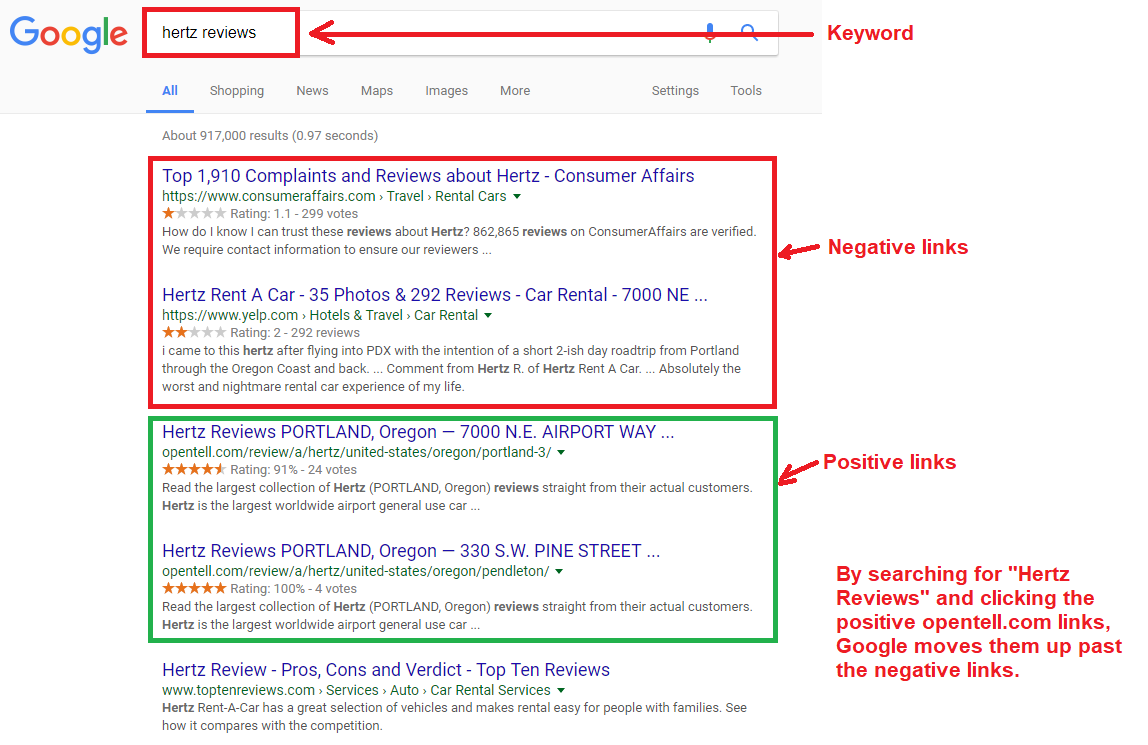Click through rate (CTR) can be an effective way of pushing down difficult links, especially those that seem to be stuck on page one of search results.
We offer click through suppression services to help suppress unwanted search results for individuals and businesses.
What Is Click Through Rate?
When you Google something and click through to a particular link, this is called Click Through Rate. This is an important signal to Google that one link is more relevant to the search query than other links. It’s helpful for moving the position of links, especially if they are on page one.
Let’s take a look at an example:

You can see the keyword “Hertz Reviews” shows two negative links for ConsumerAffairs.com and Yelp appearing in positions #1 and #2.
In positions #3 and #4 are two positive links from opentell.com.
If Hertz wanted to push down the two negative links from Consumer Affairs and Yelp, one strategy they could employ is Click Through.
What we do is have real people:
- Search for “Hertz reviews”
- Click and interact with the positive opentell.com links we want to push up
When Google’s algorithm recognizes that more people are “clicking through” to these links as opposed to the current top two negative links, the algorithm has no choice but to move the opentell.com links up, thereby displacing the unwanted search results from Consumer Affairs and Yelp.
Why Is Click Through Rate Important?
Remember, Google is an algorithm that provides search results.
Google’s mission is to help us find what we want, fast.
If it does that, we keep using Google. If we don’t easily find what we want, we might switch to another search engine, like Bing or Yahoo.
Therefore, Google has to constantly refresh and update it’s search results based on the data it compiles from real users like you and me.
If we send the signal over and over and over that opentell.com links are more relevant to the search query “Hertz Reviews,” Google’s algorithm should boost them higher in search results so people can find them easier.
When To Use “Clicks” For Suppression
Click-through rate strategy is best used after you’ve created a lot of positive content that is well-optimized to rank for your name or whatever keyword we’re targeting.
We typically won’t use click-through to promote links we don’t feel are relevant to the search query.
Ideally, we’ll use this strategy at a time when we’ve created websites, press releases, top ranking social media, interviews and other positive digital assets and yet we still have been unable to move a stubborn link from page 1, like a news story.
For some, CTR is the last bullet in the gun we use to try to push your campaign over the finish line.
So, where the first few months of your online reputation management campaign would be used to create new positive content and promote existing positive content, the click through campaign would come after that, trying to push up those positive assets, while suppressing the negative links.
When Not To Use Click Through Rate
Click through rate works best when we’re trying to manipulate page one search results or top of page two search results in Google.
It’s typically not a good strategy for trying to promote a positive link from page 5 to page 1.
It’s not a good strategy if you don’t already have at least 10-15 positive links to click on.
That’s why click through is often implemented near the end of a campaign, to give the final push to get stubborn unwanted links off page one.
Is Click Through Rate Guaranteed To Work?
No.
We’ve had some cases work really well. Others haven’t changed much at all.
Click through isn’t a magic bullet to push down unwanted SERPs, but it does work around 60% of the time for the clients we’ve used it for.
As mentioned, click through alone is usually not why people hire us, but it is an effective way of suppressing negative links when we’ve exhausted other options and are moving toward the end of a campaign.
